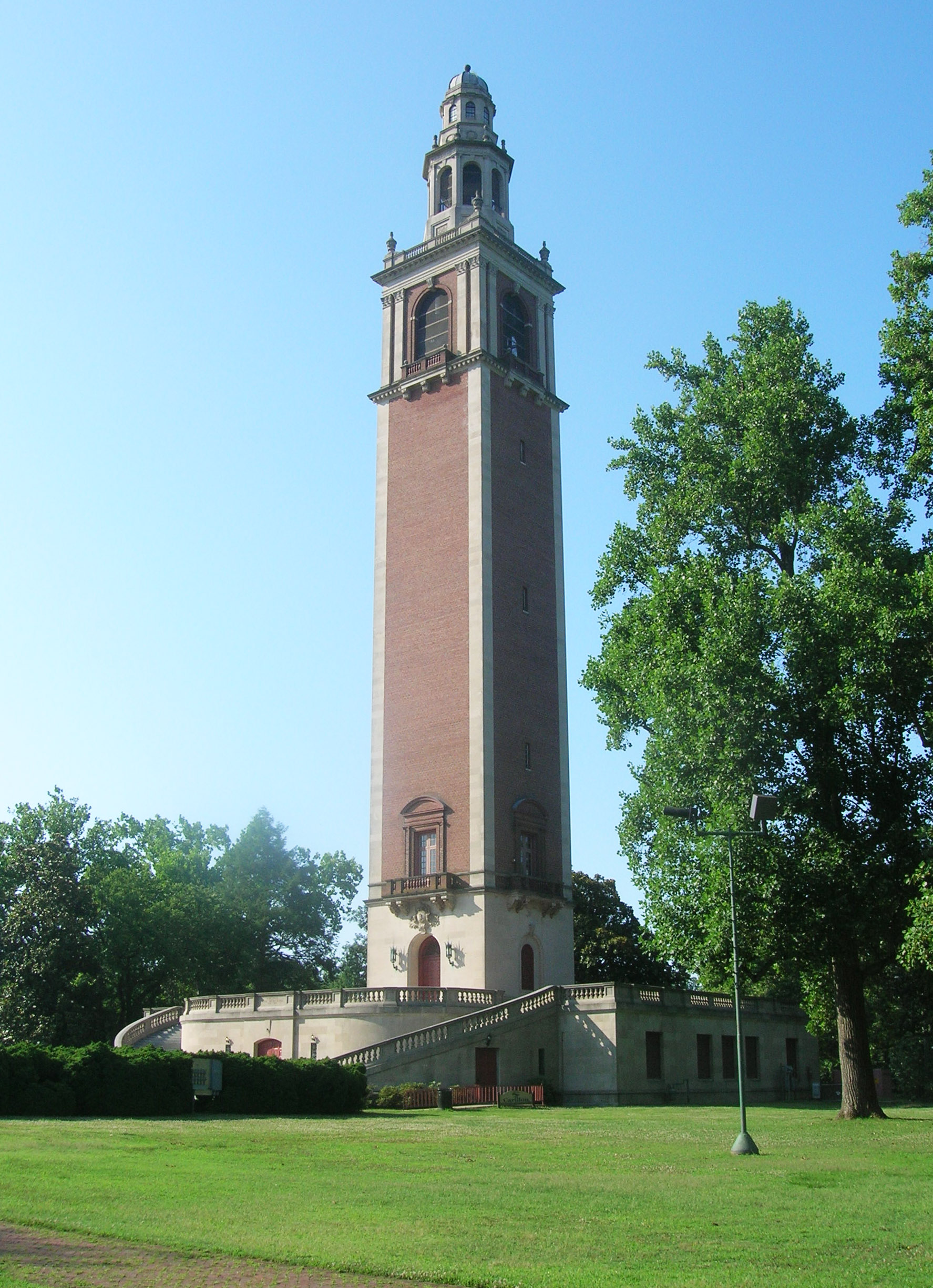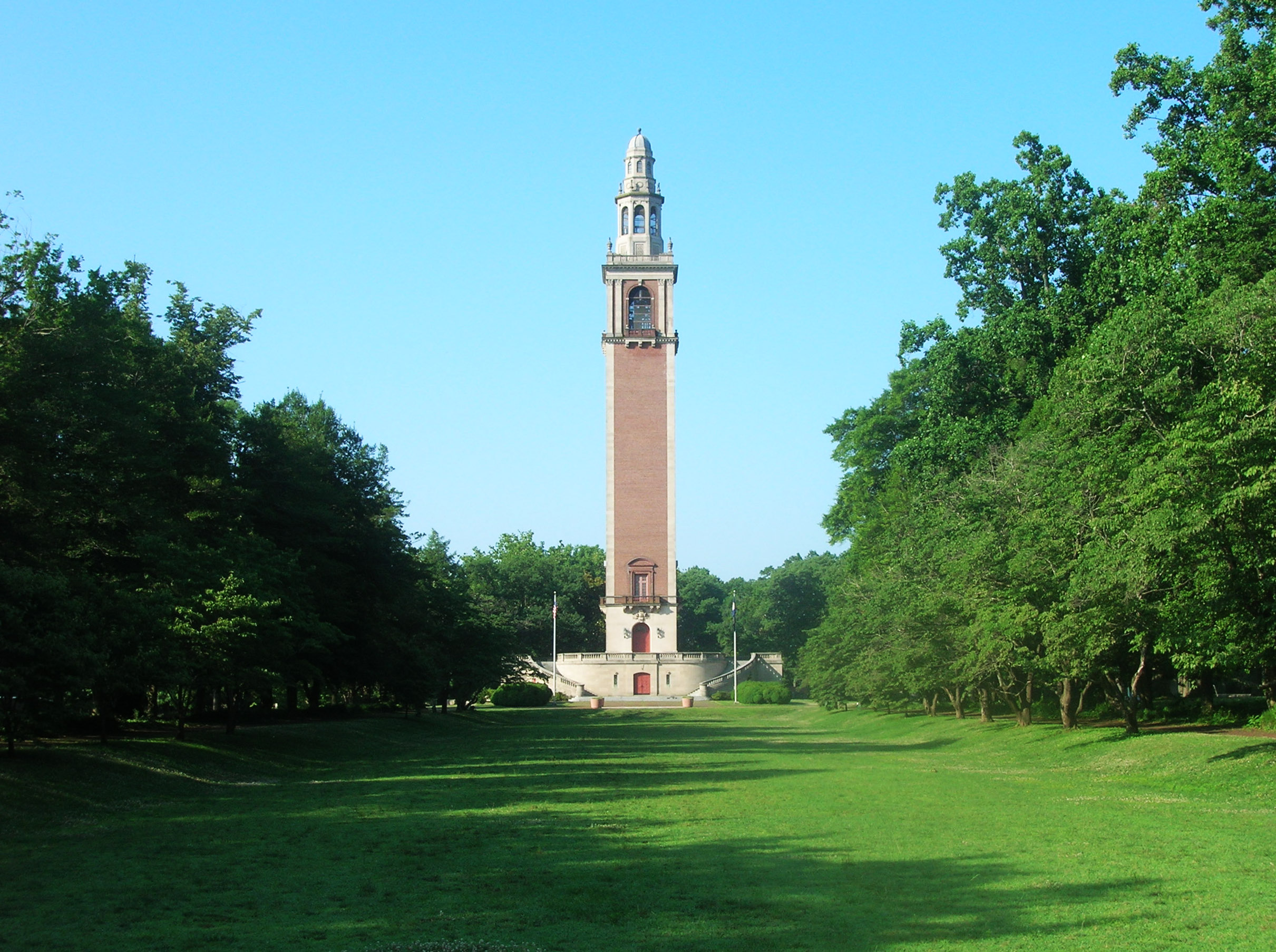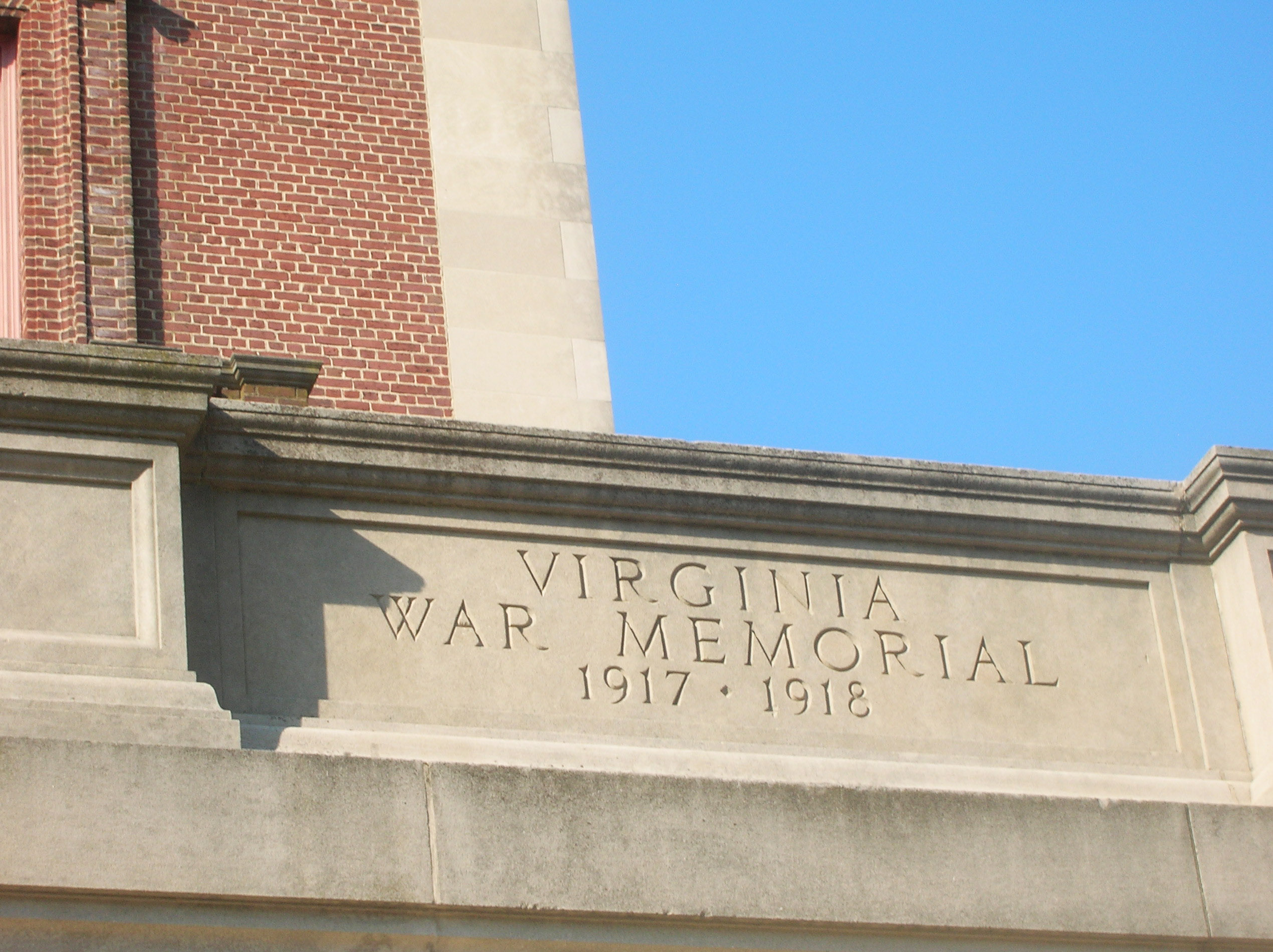The Virginia World War Memorial Carillon
Dedicated 1932

Rising a lofty 240 feet in the heart of Richmond’s William Byrd Park stands the Virginia War Memorial Carillon—the Commonwealth’s official monument to the approximately 3,700 men and women from the state who died as a result of World War I. The Georgian-revival tower houses a massive musical instrument made up of fifty-three fixed bronze bells of varying sizes, still played today by a carilloneur who strikes a pedal keyboard just below the bell chamber.
Dedicated on October 15, 1932—fourteen years after the end of the Great War—the Carillon opened amidst a swirl of patriotic fervor and controversy. Its original design, commissioned several years earlier by the Virginia General Assembly from celebrated Philadelphia architect Paul Cret, called for a sleek classicized temple. Shortly after ground breaking, a citizen’s committee waged a successful popular campaign to build a carillon instead. Fueled by supporting articles from leading newspapers and endorsements from prominent organizations, the legislative body reversed itself and awarded the project instead to the renowned Boston firm of Ralph Adams Cram in association with Carneal, Johnston, & Wright of Richmond. Building the more expensive “singing tower”—a brick encased steel frame that originally supported the heavy bells cast by John Taylor & Co. of Loughborough, England—required additional fundraising to achieve the final cost of $325,000.
Opening ceremonies, which drew a crowd of 15,000 spectators, launched with military pageantry that included seven bands, thousands of veterans, active duty National Guard units, as well as Virginia Military Institute and Virginia Tech cadets—all parading from the State Capitol. Speeches by international dignitaries alternated with musical interludes performed on the Carillon. The month-long celebration that followed included a dozen additional bell concerts. Visitors touring the memorial delighted in its ground floor museum, which featured donated photographs, posters, uniforms, flags, weapons, and other artifacts from the Great War (now in the collection of the Virginia War Memorial Museum, Newport News, Va.).

As the memorial opened in the midst of the Great Depression, budgetary compromises altered further plans for the Carillon’s building and surrounding landscape. The walls of the tower’s ceremonial second floor, intended to feature plaques with the names of Virginia’s war dead, remained blank. Shortfalls also forced the cancellation of an extensive reflecting pool to the north—excavated but never completed. In the late 1930s, workers from federally funded Works Progress Administration (WPA) completed walks, terraces and steps while members of local garden clubs provided plantings along the sunken mall. A final embellishment came in 1940: a large gold star made of terrazzo laid into the floor of the entry plaza. Paying tribute to mothers who lost sons in the so-called “War to End All Wars,” the emblem would take on additional somber resonance as the U.S. entered World War II the following year.
Over subsequent decades, the Carillon has remained a beloved landmark. Operated and maintained through a partnership between the Commonwealth and the City of Richmond, the memorial still provides annual holiday concerts and towers above ongoing park activities and festivals. The Carillon is listed as a Virginia Historic Landmark and on the National Register of Historic Places, and its sweeping vista along the sunken mall remains a historically significant expression of the era’s City Beautiful movement. It has undergone several extensive restoration campaigns, including the refurbishment of the original sixty-six bells in 1970, resulting in the recasting of several bells bringing the count to fifty-three.
The approaching centennial anniversary of World War I (2017-2018), promises a pending restoration effort by the Commonwealth and renewed opportunity for all to appreciate the historic site and recall the sacrifices it commemorates.
—Elizabeth L. O’Leary, Carillon Civic Association, August 2016

For further reading
Brownell, Charles, et al. The Making of Virginia Architecture (1992)
Kern, Susan A. “Virginia’s World War I memorial: government versus public opinion” (1990), M.A. thesis, University of Virginia
McClane, Debra A. “William Byrd Park,” nomination, National Register of Historic Places, (2015)
O’Leary, Elizabeth L. The Carillon Neighborhood: A History (2013)
Potterfield, T. Tyler. Nonesuch Place: A History of Richmond Landscape (2009)
Witek, Jessica Lambertz. “Creating Virginia’s War Memorial Carillon in the Shadow of the Civil War (2014), M.A. thesis, Virginia Commonwealth University

Timeline
1918
Immediately after armistice, proposals appear in Richmond newspapers to build public library in Richmond that would also serve as a memorial to Virginia’s war dead.
1920
General Assembly passes an act to create a War Memorial Library and establishes a War Memorial Commission to join existing State Library Board to oversee planning. American Legion joined effort when it became apparent that the groups were in conflict.
1922
Joint committee disbands; General Assembly appoints a new War Memorial Commission to oversee planning for a monument instead of library, setting building guidelines and $250,000 expenditure.
1924
Commission institutes national design competition, led by Prof. Warren Laird, Architecture School, University of Pennsylvania. In previous year, commission selects site in William Byrd Park, high point of ground to be donated by the City of Richmond.
Competition jury unanimously selects design for Virginia Tomb of the Unknown Soldier by prominent Philadelphia architect, Paul Cret, in association with Richmond architect Marcellus E. Wright.
1925
Granville Valentine, president of Valentine Meat Juice Co., leads a citizens’ movement to replace the Cret design with a carillon memorial and builds popular support through Richmond newspapers.
1926
After cornerstone laid for Cret design, the state halts construction to consider a carillon. The Commission protests and disbands. General Assembly appoints a new War Memorial Commission with instructions to select a carillon design. After another competition, it selects a colonial revival bell tower proposed by Cram & Ferguson, led by prominent Boston architect Ralph Adams Cram, in association with Carneal, Johnston, & Wright of Richmond. Private fundraising commences to raise additional $75,000 difference in cost above Cret proposal.
1930
City of Richmond passes ordinances to maintain and manage the War Memorial Carillon and its grounds in perpetuity.
1932
After construction delays, complicated by commencement of Great Depression, the 240-foot Virginia War Memorial Carillon is dedicated on October 15, 1932, recognizing the “patriotism and valor of the soldiers, sailors, marines, and women from Virginia who served in the World War.” The tower featured 66 bells, forged by John Taylor & Co. of Loughborough, England, and included a war museum on its first floor, with artifacts donated by soldiers and their families.
Landscape design is completed by Ernest Gilbert, City of Richmond Department of Public Works. However, Depression-era funding constraints prevent completion of the formal landscaping plan. What was excavated to be a reflecting pool becomes a grassy sunken mall.
1936-39
Va. Acts of Assembly transfers custody of Carillon to State Commission on Conservation and Development.
Site plantings are planned and donated by the James River Garden Club along the sunken basin; Richmond Federation of Garden Clubs plants 500+ dogwoods to the east—the beginning of “Dogwood Dell.”
1940s-70s
1940 – Completion of the terrazzo Gold Star emblem laid into the floor of the entry plaza.
The Carillon tower and grounds were in regular use for Sunday bell concerts (May-September), war memorial ceremonies, leisure activities, flower and art shows.
Subsequent decades bring limited and sporadic maintenance, while the the condition of bell tower deteriorates severely, primarily from water damage from roof and observation deck leakage.
In 1962-1964, the City returns some war relics to donors and sends those remaining to the War Memorial Museum of Virginia in Newport News.
1969-70
With a donation from the late Buford Scott, some capital repairs are undertaken and the bells are restored by original British manufacturer John Taylor & Co. Thirty-four bells are removed and recast into twenty-one, bringing total number to fifty-three.
1980-81
State inspectors condemn and close the Carillon as a fire and safety hazard. A citizens’ committee, led by a neighboring resident Elizabeth Vermillion (affiliated with the Carillon Civic Association) brings the plight of the monument to the attention of city and state officials, as well as to the press.
1983-84
The Carillon Fund, a project of Greater Richmond Community Foundation (Mrs. Linda Johnson Robb and Hon. Edward Willey as honorary co-chairs), leads a campaign that funds a $1.4 million renovation through state, municipal, and private donations. Restoration is completed and the building rededicated on Nov. 11, 1984.
1984
The Carillon is designated a Virginia Historic Landmark and is placed on the National Register of Historic Places.
1986
City adopts an ordinance to establish the Carillon Advisory Committee, a voluntary citizen’s group of eight Council-appointees (each serving a three-year term) to assure the preservation and maintenance of the Carillon and its grounds by monitoring its use and condition and advising the City’s Dept. of Recreation and Parks.
2000
Va. Department of Historic Resources erects a highway marker for the Carillon.
General Assembly legislates that the Department of General Services enter agreement allowing City to collect user fees and cell tower lease fees for Virginia World War Memorial Carillon to be used solely for the structure’s upkeep, maintenance and improvement.
2014-2016
The international centennial anniversary for World War I commences (Europe entered the conflict July 28, 1914). In preparation for the national observance of the anniversary of U.S. involvement, 2017-18, the Virginia General Assembly passes a Joint Resolution March 8, 2014, naming the Carillon Advisory Committee as the official “World War I 100th Anniversary Committee.”
With City and State support—as represented by City Councilman Parker Agelasto and Delegate Betsy Carr, in whose districts the Carillon stands—and various statewide community and organization representatives along with the remaining Carillon Advisory Committee members organize the Virginia World War I Centennial Committee and the non-profit Virginia World War I Centennial Foundation.
In early 2016, the General Assembly and the City of Richmond agree to transfer stewardship of the Carillon to the Commonwealth. The General Assembly also folded the centennial committee under the umbrella of the Virginia World War I and World War II Commemorative Commission.
2017-2018
Centennial of U.S. involvement in World War I brings renewed interpretive focus on and celebration of the Virginia World War Memorial Carillon.
